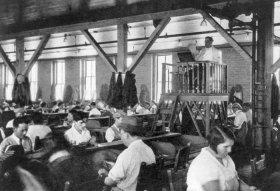There are different versions of how it started or did the beautiful tradition of Cuban factories readers and its protagonists. This time we will refer to only two sources of information considering them certain.
Its beginnings
In 1865, only in Havana, there were over five hundred cigar factories which were used in more than fifteen thousand artisans.
In its founder and exceptional study entitled “Reading in cigar”, José Rivero Muñiz said that the idea of reading aloud in the workplace was the Spanish traveler Jacinto de Salas y Quiroga who visited Cuba in 1839 and made a trip to a coffee plantation. Seeing there slaves choosing different coffee beans came up with the idea that “there is nothing easier than using those hours ahead of the moral education of those unhappy beings”.
He said about the Cuban scholar Fernando Ortiz, in ‘The Cuban Counterpoint snuff and sugar’ which, according to the Rev. Manuel Deulofeo, where there was a reader first cigar was in the town of Bejucal, in 1864, named Antonio Leal. And that: “In Havana reading in cigar was introduced in 1865, to urge Nicholas and was factory Azcárate” Le Figaro “, which allowed the first reading in their workshops” The following year he did Jaime Partagas in workshop. Then there would be many more.
“Paying for hear, hear pay for reading!” Exclaimed very pessimistic writer (newspaper) The Century, but his suspicion was unfounded and in cigar was read every day and artisans paid to read, “writes Fernando Ortiz.
Upon his importance Fernando Ortiz himself says: “Through reading aloud the tobacconist’s shop has had its internal propaganda organ. The first reading was in a cigar factory in Havana was the book entitled The Fights of the Century. ”
Sage adds: “The reading table of every cigar was, as Marti said, advanced platform of freedom. When, in 1896, stirred revolutionary Cuba against Bourbon absolutism and war for independence, a gubernatorial proclamation of June 8, 1896 tobacco silences the stands. ”
From 1865 to date, coinciding with the development of the production of tobacco, Nicolas Azcarate Cuban political liberal, to see the support of the reformists regarding education, tobacco (artisans) saw the need to start a newspaper dedicated to workers and thus, together with Manuel Sellén first drafted the weekly La Aurora. Weekly Newspaper Dedicated to Artisans which came to light on October 22, 1865.
Another Spanish, Saturnino Martinez who also worked nights in the public library of the Economic Society of Friends of the Country, as director of the Liceo de Guanabacoa, opened there the first public gallery that existed in Cuba. Azcárate once referred to certain religious orders in some of its members read aloud in the refectory while the rest of the community lunch. His words were echoed by the listeners of the Lyceum, Saturnino Martinez obviously assumed for the workers and is a reading. For dates recognizes that reading was first introduced in the galleys of prison workers “cigar” that was in the Arsenal station of Havana, and from there to the cigar shops.
The initiators of the Aurora (with the support and advice of reformist politicians like Nicolas Azcarate) felt the need to educate the craft through reading aloud as the cigar of snuff did their work. The first reading took place in the cigar shop “Le Figaro” on December 21, 1865, as announced by an article entitled “Reading in the workshops”: Publication of this article was a kind of manifesto or propaganda promoted not only reading the newspaper itself but reading aloud as an institution within the workshops. The fascinating thing is that, according to the same text, from the beginning the same workers elected a reader and each contributed to tobacco compensate for time lost from work. Slowly reading was instituted in several workshops and from a podium reading the reader chosen by the time agreed between the factory owners, foremen and craftsmen.
Censorship and Abuse
But in this tradition that became tobacco factory reader also suffered from cancellations and abuse. The first ban on Tobacco readings came from the political government of Havana and its text diminishes the ability of understanding listeners offensively. One paragraph reads: “It also happens that reading newspapers is passed to the books containing sophistry or harmful to the weak maximum intelligence of people who do not possess the necessary study criteria and to judge rightly demonstrations writers , pretending to fulfill the mission of educating the people, they often stray into serious damage to the peace of families “.
Reading tobacco and reader are historical figures who contributed as little Cuban-en-masse to raise the culture of many Cuban families, as the first cigar and strippers (male and female) then took it home to the wise knowledge and their guilds and unions then came important Cuban leaders at one time or another. And consumers are still active and popular vehicle of our culture and world culture.
José Martí, found in the enlightened Cuban emigres cigar factories in Tampa, Ybor City and even New York, collaborators and contributors indispensable to the cause of Cuba Libre.
Some of the most fiery speeches were delivered by José Marti from the stands of the readers of tobacco, such as factories Vicente Martinez Ybor Spanish and Cuban Eduardo Hidalgo Gato, and a reader of this industry, Francisco Maria Gonzalez, who was picked stenographically Martí’s famous speech in Tampa Lyceum entitled “With all and for the good of all.”
Sources: Wiki/Tijerino/Ortiz/Alfonso/InternetPhotos/www.thecubanhistory.com
The Cigar factory reader in Cuba/ Arnoldo Varona, Editor
www.thecubanhistory.com
EL LECTOR DE TABAQUERIA EN CUBA. JOSE MARTI.
Hay distintas versiones de como comenzó o surgió la bella tradición cubana del lector de tabaqueria y sus protagonistas. En esta ocasion nos referiremos a solo dos de las fuentes de informacion por considerarlas mas seguras y ciertas.
Sus comienzos
En 1865, solamente en La Habana, había más de quinientas tabaquerías en las cuales se empleaban más de quince mil artesanos.
En su fundador y excepcional estudio titulado “La lectura en las tabaquerías”, José Rivero Muñiz señala que la idea de la lectura en voz alta en el lugar de trabajo fue del viajero español Jacinto de Salas y Quiroga quien visitó Cuba en 1839 e hizo una excursión a un cafetal. Al ver allí a los esclavos escogiendo diferentes granos de café se le ocurrió la idea que “nada más fácil había que emplear aquellas horas en ventaja de la educación moral de aquellos infelices seres”.
Al respecto dice el sabio cubano Fernando Ortiz, en ‘El contrapunteo cubano del tabaco y el azúcar’ que, según el Reverendo Manuel Deulofeo, donde primero hubo un lector de tabaquería fue en la villa de Bejucal, en 1864, llamado Antonio Leal. Y que: “En La Habana la lectura se introdujo en las tabaquerías en 1865, a impulso de Nicolás Azcárate y fue la fábrica “El Fígaro”, la primera que permitió la lectura en sus talleres” Al año siguiente lo hizo Jaime Partagás en su taller. Luego serían muchas más.
“¡Pagar por oír hablar, pagar por oír leer!”, exclamaba muy pesimista el escritor de (el periódico) El Siglo, pero su desconfianza fue infundada y en las tabaquerías se leyó cada día y los artesanos pagaron por leer”-escribe Fernando Ortiz.
Sobre su importancia dice el propio Fernando Ortiz: “Por medio de la lectura en alta voz el taller de la tabaquería ha tenido su órgano de propaganda interna. La primera lectura que se dio en una tabaquería de La Habana fue la del libro titulado Las Luchas del Siglo.”
El sabio agrega: “La mesa de lectura de cada tabaquería fue, según dijo Marti, tribuna avanzada de la libertad. Cuando, en el año 1896, se agita Cuba revolucionaria contra el absolutismo borbónico y guerrea por su independencia, un bando gubernativo del 8 de junio de 1896 hace callar las tribunas tabaqueras.”
A partir de 1865 y fecha y coincidiendo con el desarrollo de la producción de tabacos, Nicolás Azcárate, político liberal cubano, al ver el apoyo de los reformistas respecto a la educación, tabaqueros (artesanos) vió la necesidad de fundar un periódico dedicado a los trabajadores y de ese modo, junto con Manuel Sellén redactó por primera vez el semanario La Aurora. Periódico Semanal Dedicado a los Artesanos el cual salió a la luz el 22 de octubre de 1865.
Otro español, Saturnino Martínez quien además trabajaba de noche en la biblioteca pública de la Sociedad Económica de Amigos del País, como director del Liceo de Guanabacoa, abrió allí la primera tribuna pública que existió en Cuba. Azcárate se refirió alguna vez a que en ciertas órdenes religiosas unos de sus miembros leía en voz alta en el refectorio mientras el resto de la comunidad almorzaba. Sus palabras encontraron eco en los oyentes del Liceo, obviamente Saturnino Martínez las asumió en favor de los obreros y de es forma de lectura. Por las fechas se reconoce que la lectura primero fue introducida en las galeras de prisión de trabajadores “cigarreros” que había en el Arsenal del Apostadero de La Habana, y de allí pasó a los talleres de tabaquerías.
Los iniciadores de La Aurora (con el apoyo y consejo de reformistas políticos como Nicolás Azcárate) sintieron la necesidad de educar al artesanado a través de la lectura en voz alta mientras los torcedores de tabaco hacían sus labores. La primera lectura se llevó a cabo en el taller de tabaquería “El Fígaro” el 21 de diciembre de 1865, según lo anunció un artículo titulado “La lectura en los talleres”: La publicación de este artículo fue una especie de manifiesto o propaganda que promovía no solamente la lectura del periódico mismo sino la lectura en voz alta como institución dentro de los talleres. Lo fascinante es que, según ese mismo texto, desde el principio los mismos trabajadores eligieron a un lector y cada tabaquero contribuyó para
compensarlo por el tiempo de trabajo perdido. Poco a poco la lectura se instituyó en varios talleres y desde una tribuna el lector elegido leía por el tiempo acordado entre los dueños de las fábricas, los capataces y los artesanos.
Censuras y Abusos
Pero en esta tradicion en la que se convirtio el lector de tabaqueria tambien sufrió de cancelaciones y abusos. La primera prohibición a las Lecturas de Tabaquería provino del Gobierno Político de La Habana y en su texto se disminuye la capacidad de entendimiento de los oyentes en forma ofensiva. Un párrafo decía: “Sucede también que de la lectura de los periódicos se pasa a la de los libros que contienen sofismas o máximas perjudiciales para la débil inteligencia de las personas que no poseen el criterio y estudio necesarios para juzgar con acierto las demostraciones de escritores, que pretendiendo cumplir la misión de instruir al pueblo, lo extravían muchas veces en grave daño de la paz de las familias”.
La lectura de tabaquería y el lector son figuras históricas cubanas que contribuyeron como pocas -en forma masiva-a elevar la cultura de muchas familias cubanas, ya que el tabaquero primero y los despalilladores (hombres y mujeres) después se llevaban a lo hogares la sabia del conocimiento y de sus gremios y sindicatos después, surgieron importantes líderes cubanos, en uno u otro tiempo. Y aún siguen siendo activos consumidores y vehículos populares de nuestra cultura y de la cultura universal.
José Martí, encontró en los ilustrados cubanos, tabaqueros emigrados en Tampa, Ibor City y hasta Nueva York, colaboradores y contribuyentes indispensables para la causa de Cuba Libre.
Algunos de los más encendidos discursos martianos fueron pronunciados desde las tribunas de los lectores de tabaquería, como los de las fábricas del español Vicente Martínez Ibor y el cubano Eduardo Hidalgo Gato, y que un lector de esta industria, Francisco María González, fue quien recogió estenográficamente el célebre discurso de Martí en el Liceo de Tampa titulado “Con todos y para el bien de todos”.
Sources: Wiki/Tijerino/Ortiz/Alfonso/InternetPhotos/www.thecubanhistory.com
The Cigar factory reader in Cuba/ Arnoldo Varona, Editor
www.thecubanhistory.com







